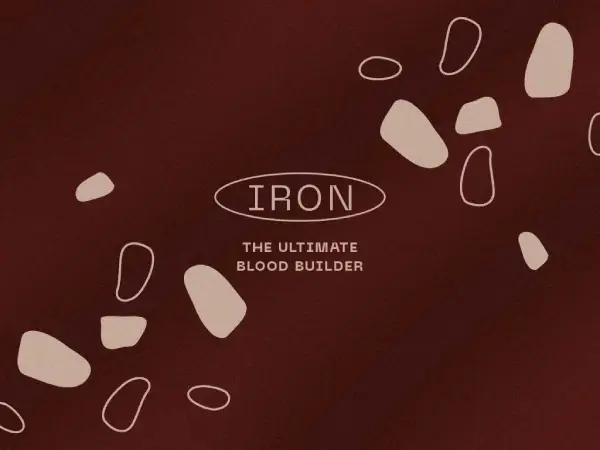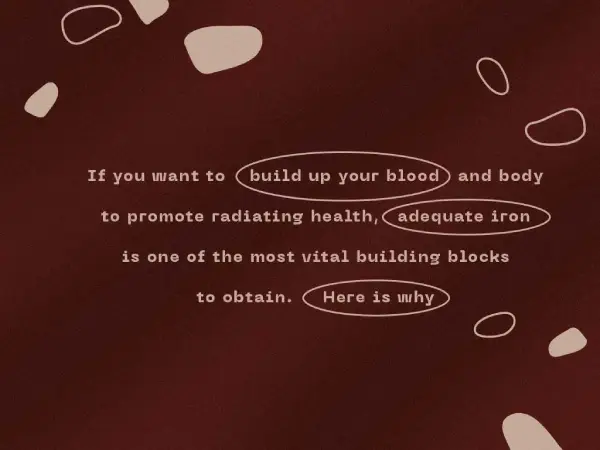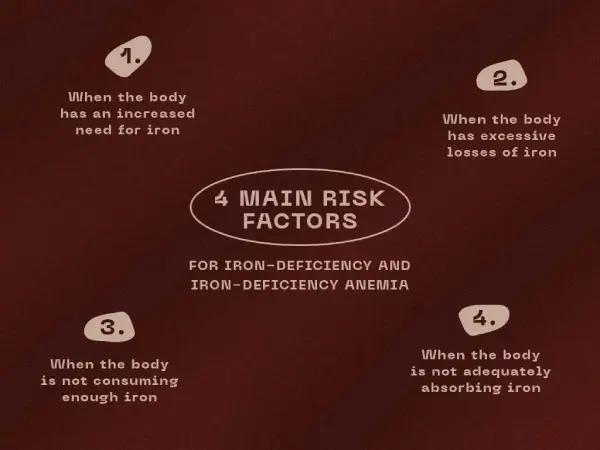Blog
Iron, the Ultimate Blood Builder

What is iron and why is it important?
Iron is a trace mineral that is essential to the body in small amounts. Did you know that over 65% of iron in the body is found in hemoglobin? Hemoglobin is the part of red blood cells that carries oxygen to all the tissues of the body. Adequate iron in the body is necessary for oxygenated blood, which every cell in the body depends on for proper function. Oxygen is the most important chemical element for our body. With no oxygen, there is no life, and with suboptimal oxygen, there is suboptimal health. This is the reason athletes do everything they can to optimize oxygenation in the body; to fuel their highest performance. Not only is healthy blood life-sustaining, it is also the cornerstone for beauty and vitality. Adequate iron is essential for healthy blood. In Traditional Chinese and Ayurvedic Medicine, blood is considered a fundamental substance that provides nourishment to the entire body; “pure” blood is a sign of good health, whereas “impure” blood is prone to disease.
Iron is a cofactor for dozens of enzymes in the body involved with energy production, amino acid metabolism, carbohydrate metabolism, collagen synthesis, thyroid hormone synthesis, DNA synthesis, antioxidant protection, microbial destruction, and more! Lastly, iron interacts with several other nutrients including vitamin C (vitamin C enhances iron absorption), copper (a copper deficiency may lead to iron-deficiency-like anemia), zinc (iron and zinc may compete for absorption), calcium (calcium can decrease iron absorption), iodine (severe iron-deficiency anemia can impair thyroid metabolism), vitamin A (low vitamin A may lead to iron accumulation in certain organs), and lead (lead poisoning may lead to iron-deficiency anemia). So, if you want to build up your blood and body to promote radiating health, adequate iron is one of the most vital building blocks to obtain.
Where do we get iron and how much do we need?
We get iron into our bodies by consuming iron-rich foods. In food, iron comes in two forms: heme and nonheme. Heme iron is found primarily in animal sources (meat, fish, poultry, and eggs) and nonheme iron in plant sources (whole grains, legumes, nuts, seeds, soy, some fruits and vegetables). The most potent sources of iron for carnivores (meat-eaters) come from beef, liver, and shellfish (like oysters). For herbivores (vegans and vegetarians), good sources include soybeans/soy products (natto, tofu, tempeh), lentils, chickpeas, dark leafy greens (like spinach), dark chocolate, cashews, sesame seeds, molasses, raisins, and prune juice. Many processed foods (bread, pasta, cereal, flour, rice) are fortified with iron, meaning that synthetic iron is added to these foods that wouldn’t otherwise contain iron.
It is important to keep in mind that nonheme iron is less bioavailable than heme iron, meaning it is not as available to the body for absorption. Certain dietary factors can enhance or inhibit nonheme iron absorption. Vegans and vegetarians should be extra conscious about how to maximize nonheme iron absorption to prevent iron deficiencies or insufficiencies. Ways to do this include using fresh lemon juice as a dressing, eating citrus fruits (and other vitamin C-rich foods) with meals, avoiding drinking coffee and tea with or just after meals, taking calcium supplements away from iron, using a cast iron skillet for cooking, soaking and sprouting whole grains and legumes (beans, peas, lentils), cooking leafy greens and vegetables, and fermenting foods. The recommended daily allowance (RDA) for iron is 8 milligrams for adult men and 18 milligrams for adult women, although needs differ based on age, sex, pregnancy, lactation, and health status. The upper limit of iron (AKA the maximum amount you should not exceed in a day) is 45 milligrams.
Why should I care about iron deficiency and iron-deficiency anemia?
According to the World Health Organization, iron-deficiency anemia is the top nutritional disorder and is the most common cause of anemia worldwide. Iron is a nutrient of public health concern for infants and women of childbearing age. In fact, it is estimated that 1/3 of all women of reproductive age are anemic. There are several different types of anemia, including aplastic anemia, sickle cell anemia, thalassemia, vitamin deficiency anemia, and iron deficiency anemia. More specifically, an iron deficiency is what causes the iron-deficiency type of anemia. Iron deficiency can have numerous negative effects on the body and, if untreated usually progresses to iron-deficiency anemia.
Iron-deficiency anemia impairs the oxygen-carrying capacity of the blood. This can cause signs and symptoms such as fatigue, paleness, weakness, depression, irritability, chest pain, heart palpitations, shortness of breath, cold hands and feet, restless legs, frequent infections, easy bruising, brittle nails, hair loss, headaches, dizziness, inflamed tongue, sores at mouth corners, and unusual cravings. Work performance and productivity are commonly impaired in people suffering from iron-deficiency anemia due to poor concentration and focus as well as reduced physical and mental endurance. In children, iron-deficiency anemia can lead to poor cognitive development, decreased attention span, and abnormal behavior patterns. In the elderly, reduced oxygen supply to the brain can lead to cognitive impairment and increase the risk of dementia. As you can see, there are many reasons to care about iron deficiency and iron-deficiency anemia.
What are the causes of iron deficiency and who is at risk?
Iron naturally leaves the body through the gastrointestinal tract, skin, urine, and menstrual blood. These losses are normal, the problem occurs when the body’s iron levels fall too low, which can happen in several different ways. Here are the 4 main risk factors for iron-deficiency and iron-deficiency anemia:
- When the body has an increased need for iron
- Infants, children, and early adolescents require more iron than usual because of rapid growth
- Pregnant women require more iron than usual because of the demands on the growing fetus
- When the body has excessive losses of iron
- Menstruating women with heavy and/or prolonged bleeding can lose more blood and iron than normal
- People with acute blood loss from surgery, injury, childbirth, and severe diarrhea
- People with chronic blood loss from internal bleeding such as with gastrointestinal ulcers
- People with hormonal disorders that increase bleeding
- People who frequently donate blood
- When the body is not consuming enough iron
- People on very restrictive diets who are not consuming enough calories, protein, or iron-rich foods
- People on a plant-based diet who have decreased bioavailability of nonheme iron
- When the body is not adequately absorbing iron
- People with digestive issues such as small intestinal bacterial overgrowth (SIBO), irritable bowel disease (IBD), intestinal parasites, or celiac disease
- People with damage or resection of the duodenum or proximal jejunum (the parts of the small intestine where iron is absorbed)
- People with achlorhydria (AKA a lack of stomach acid, which is needed to absorb iron)
- People taking medications long-term that increase pH of the digestive tract such as antacids and proton pump inhibitors (PPI)
How do I know if I am iron deficient?
The best way to find out if you are iron deficient, or insufficient, is to get your blood work done. An anemia blood panel will include the following markers:
- Complete Blood Count (CBC)
- In iron deficiency anemia red blood cells will be smaller (microcytic) and paler (hypochromic) than normal, and there will be depressed levels of total red blood cells, hemoglobin (iron-containing oxygen transport protein in RBCs), and hematocrit (the fraction of whole blood made up of RBCs
- Iron panel
- In iron deficiency anemia, iron saturation (% of iron bound to its transport protein) and serum iron (amount of iron in the bloodstream) will be depressed. However, total iron-binding capacity (RBCs ability to bind to its transport protein) and transferrin (iron’s transport protein) will be elevated
- Ferritin
- This is the amount of iron storage in your body and the most reliable indicator of total body iron status. It is usually the first marker to decrease when iron is depleted, and it will be depressed in iron-deficiency anemia
- Note: the levels for all the above blood markers will vary in states of iron depletion versus iron deficiency anemia as well as in certain states of health
Testing can be done with a Naturopathic Doctor at LIVV who will take your medical history, signs/symptoms, and test results into consideration, and evaluate your need for iron therapy. It is important to note that naturopathic doctors consider optimal ranges of blood markers, not just the standard ranges. This means that we optimize your levels before they fall out of standard ranges, therefore preventing disease and promoting peak health.
How can I replete my iron levels at LIVV?
Iron therapy will be completely individualized to the patient at LIVV. There are different methods of repleting iron in the body that include using food as medicine, modifying cooking methods, supplementing oral iron, or getting IV infusions of iron. A combination of these methods may be used. Naturopathic doctors at LIVV will also emphasize hormonal and digestive health to promote healthy iron levels and blood building. LIVV is proud to offer an IV iron infusion (Venofer), that will be dosed depending on your unique needs. This is the most effective way to get your iron levels back up if you are very depleted because IVs provide 100% absorption of nutrients since they enter directly into your bloodstream.
Iron supplementation is only indicated for the prevention and treatment of iron deficiency and iron deficiency anemia, which requires the care of a licensed medical provider. An interesting fact about the body is that it has no way of getting rid of excess iron. Supplementing iron in the wrong dosages could cause gastrointestinal side effects (such as abdominal pain, nausea, constipation, dark stools) and possibly lead to acute toxicity (which can be dangerous). This is why most multivitamins do not contain iron in them.
Chronic iron toxicity is also possible but usually occurs in people with a genetic disorder known as hemochromatosis that causes your body to over absorb iron. This condition can also be ruled with a naturopathic doctor at LIVV if necessary. For your safety, IV iron infusions at LIVV require bloodwork or a doctor’s referral. Overall, preventing and treating iron deficiency is a relatively simple way to avoid serious complications and to feel better in general. Your naturopathic doctor will make the recommendation that is right for you, so make your appointment with us today to get started!
Written by Jordan Valdez, RDN
References:
Stepnick, Gropper Sareen Annora, et al. Advanced Nutrition and Human Metabolism. Cengage Learning, Inc., 2022.
Nahikian-Nelms, Marcia. Nutrition Therapy and Pathophysiology. Cengage, 2020.
Miller JL. Iron deficiency anemia: a common and curable disease. Cold Spring Harb Perspect Med. 2013;3(7):a011866. Published 2013 Jul 1. doi:10.1101/cshperspect.a011866
“Resources.” Food Sources of Select Nutrients | Dietary Guidelines for Americans, https://www.dietaryguidelines.gov/resources/2020-2025-dietary-guidelines-online-materials/food-sources-select-nutrients.
“Anaemia.” World Health Organization, World Health Organization, https://www.who.int/health-topics/anaemia#tab=tab_1.
“Anemia.” Mayo Clinic, Mayo Foundation for Medical Education and Research, 8 Sept. 2021, https://www.mayoclinic.org/diseases-conditions/anemia/symptoms-causes/syc-20351360.
Dr An Duy Tran, University of Melbourne. “How Can Heartburn End up as Anaemia?” Pursuit, The University of Melbourne, 11 Oct. 2021, https://pursuit.unimelb.edu.au/articles/how-can-heartburn-end-up-as-anaemia.
“Blood and Circulation Health.” School of Ayurvedic Diet & Digestion, https://www.joyfulbelly.com/Ayurveda/symptoms/Blood-and-Circulation.
Blood from a TCM Perspective, http://www.shen-nong.com/eng/principles/blood.html.
Iron. (2021, January 1). Linus Pauling Institute. https://lpi.oregonstate.edu/mic/minerals/iron#calcium


